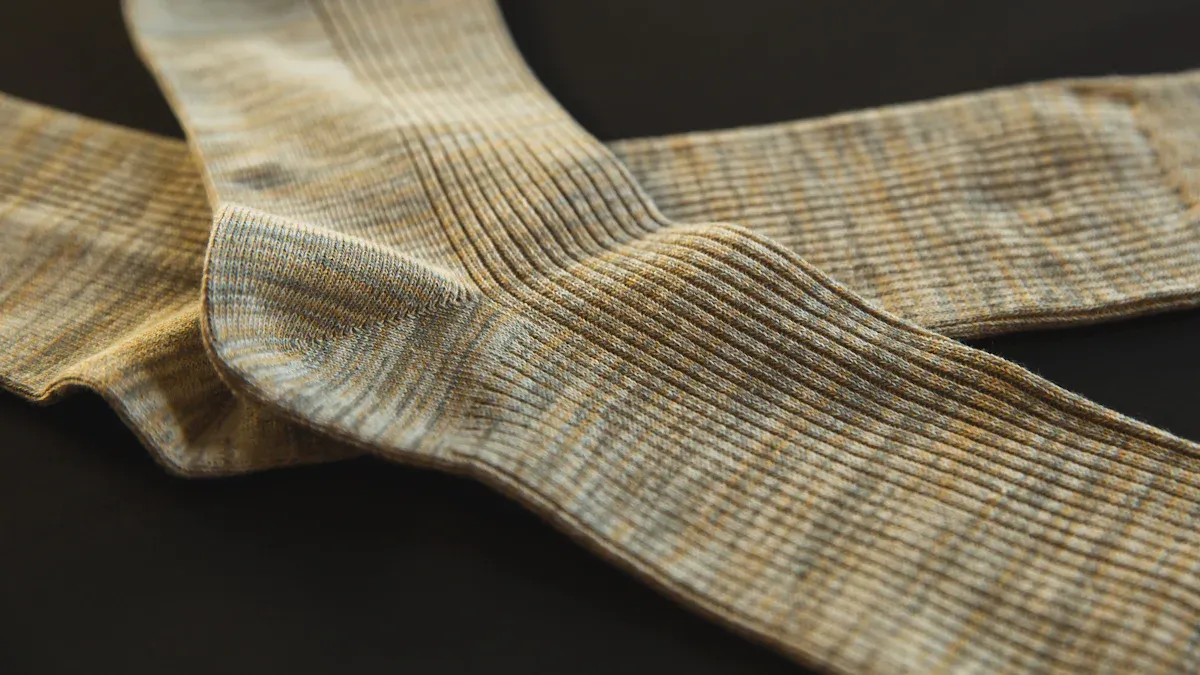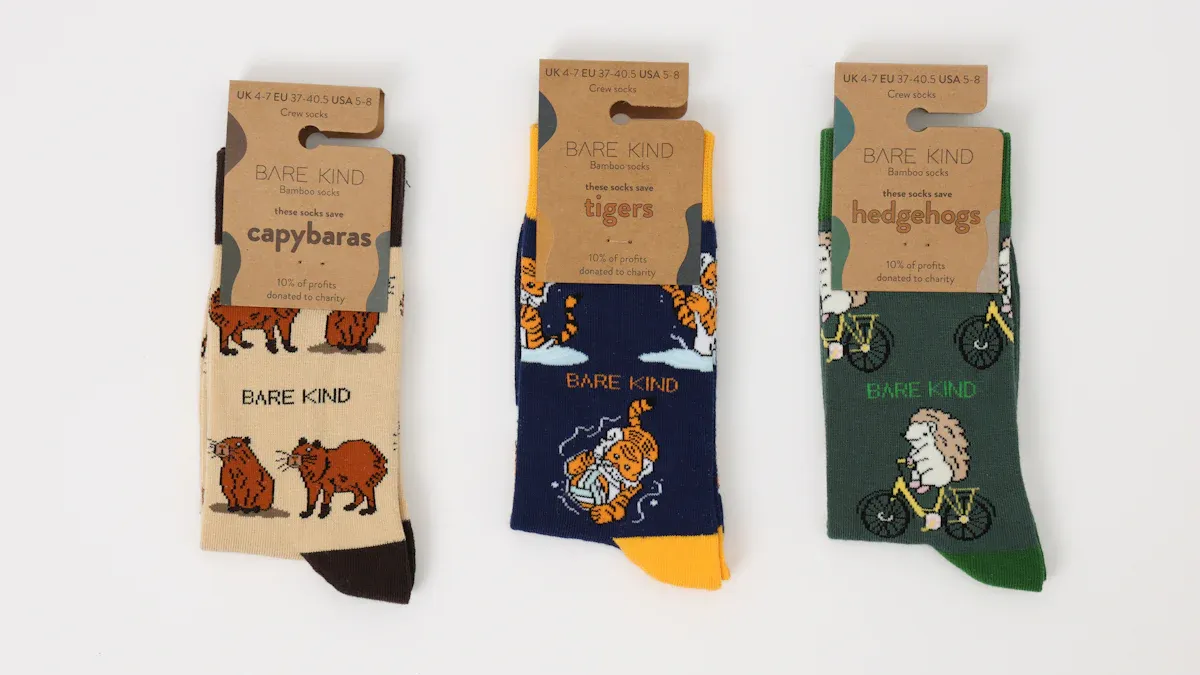
If you think compression socks are stuffy or uncomfortable, think again!
Modern compression socks are designed with your comfort in mind. They use advanced materials like breathable fabrics to keep air flowing around your feet. This means you can wear them in hot weather without worrying about sweaty or overheated feet. Plus, clever design features, like mesh panels, help improve airflow even more.
These socks don’t just support your circulation—they also keep your feet cool and dry all day long.
Key Takeaways
- Today's compression socks are made with materials like nylon and spandex. These help keep your feet cool and dry.
- Some socks have mesh panels to let air flow better. This stops your feet from getting too hot during activities.
- Breathable socks pull sweat away, helping prevent blisters and bad smells. This makes them comfy to wear all day.
- Pick a compression level that fits your needs. This gives good support while staying comfortable.
- These socks work great for hot weather, sports, or long trips. They help blood flow and make your legs less tired.
What Makes Compression Socks Breathable?

Materials That Promote Breathability
The secret to breathable compression socks lies in the materials used to make them. Advanced fabrics, like nylon and spandex blends, are designed to let air flow freely while still providing the support you need. These materials often include moisture-wicking properties, which means they pull sweat away from your skin. This keeps your feet dry and comfortable, even during long hours of wear.
Thanks to advancements in textile manufacturing, modern compression socks are more breathable than ever. Researchers have found that these materials not only improve comfort but also enhance airflow, making them ideal for hot weather or intense activities. So, whether you're running errands or running a marathon, you can count on these socks to keep your feet cool and fresh.
Design Features for Enhanced Airflow
Breathability isn't just about the fabric—it's also about how the socks are made. Many compression socks include clever design features like mesh panels or ventilation zones. These areas are strategically placed to allow maximum airflow, especially in spots where your feet tend to get the hottest.
Studies show that socks with high air permeability and low thermal resistance are perfect for summer conditions. For example:
- Mesh panels in ankle socks improve airflow and help regulate temperature.
- Breathable fabrics prevent overheating during physical activities.
These design elements work together to ensure your feet stay cool, no matter how active you are.
Role of Technology in Improving Comfort
Technology plays a big role in making compression socks more breathable and comfortable. Modern manufacturing techniques allow for precise control over fabric structure, ensuring the perfect balance between support and airflow. For instance, studies have shown that the structure of woven fabrics directly affects air permeability and moisture management.
Here’s a quick look at some research findings:
| Study | Focus | Findings |
|---|---|---|
| Havlová (2013) | Air permeability and constructional parameters | Found a strong link between fabric structure and breathability. |
| Umair et al. (2016) | Structure of woven fabric | Showed how fabric design impacts airflow and moisture control. |
| Zhu et al. (2018) | Structural parameters of cotton woven fabric | Predicted how fabric structure affects air permeability. |
| Marie (2018) | Air and water vapor permeability | Highlighted key factors that improve breathability. |
These advancements mean you can enjoy the benefits of compression socks without sacrificing comfort. Whether you're traveling, working, or exercising, the right technology ensures your socks feel as good as they perform.
What's the Benefits of Breathable Compression Socks?
Temperature Regulation for Hot Weather
Have you ever dreaded wearing socks in the summer because of the heat? Breathable compression socks solve that problem by keeping your feet cool, even on the hottest days. Their advanced materials and design allow air to circulate freely, preventing your feet from feeling trapped or overheated. This makes them perfect for outdoor activities, workouts, or just running errands in warm weather.
The secret lies in their ability to regulate temperature. By allowing heat to escape and fresh air to flow in, these socks create a comfortable environment for your feet. You’ll notice the difference, especially when you’re on your feet for long periods. Whether you’re hiking, traveling, or simply enjoying a sunny day, breathable compression socks ensure your feet stay cool and comfortable.
Moisture-Wicking to Keep Feet Dry
Nobody likes sweaty feet, right? Breathable compression socks are designed to wick away moisture, keeping your feet dry and fresh all day. The fabrics used, like nylon and spandex blends, actively pull sweat away from your skin. This not only prevents discomfort but also reduces the risk of blisters and odors.
Here’s a quick look at how these socks perform based on lab tests:
| Feature | Observation |
|---|---|
| Moisture-wicking capability | Kept feet cool and dry |
| Compression comfort | Light, comfy compression made a noticeable difference |
| Fatigue reduction | Feet and legs felt less tired and heavy |
| Durability | Washed well without pilling or stretching out |
With these features, you can confidently wear your compression socks during workouts, long walks, or even a full day at work. Say goodbye to damp, uncomfortable feet and hello to a fresh, dry feeling.
Comfort During Extended Wear
Wearing socks for hours can sometimes feel like a chore, but not with breathable compression socks. These socks are designed for extended wear, ensuring your feet stay comfortable no matter how long you have them on. Dr. Marcus Duda, a foot and ankle specialist, highlights the importance of comfort in compression socks. He developed Vive Wear socks using premium materials like alpaca and merino wool, which enhance breathability and moisture-wicking properties. This thoughtful design makes them ideal for all-day use.
You’ll appreciate how these socks reduce fatigue and keep your legs feeling light. Whether you’re traveling, working a long shift, or recovering after exercise, they provide the support you need without sacrificing comfort. Their durability also means they’ll hold up well after multiple washes, making them a reliable choice for daily wear.
In What Scenarios Does Sock Breathability Truly Matter?

Summer and Warm Weather Activities
When the sun is blazing, the last thing you want is sweaty, uncomfortable feet. Breathable compression socks are a game-changer for summer activities. They keep your feet cool and dry, even when temperatures soar. Whether you're hiking, gardening, or just enjoying a walk in the park, these socks help regulate temperature and prevent overheating.
Here’s why they’re perfect for warm weather:
- Improved circulation reduces swelling and discomfort caused by heat.
- Moisture-wicking fabrics keep your feet dry, avoiding that sticky feeling.
- Enhanced airflow prevents fluid buildup, especially if you’re standing or sitting for long periods.
With these benefits, you can stay active and comfortable all summer long.
Sports and Athletic Performance
If you’re into sports or fitness, breathable compression socks can give you an edge. They’re designed to support your muscles while keeping your feet fresh. A systematic review of 21 studies found that while compression socks don’t always boost performance directly, they do help with muscle recovery. Athletes reported less soreness and better muscle function after workouts.
Another study showed that compression socks might not change your heart rate or oxygen levels during exercise, but they can reduce muscle fatigue. This means you’ll feel less tired after a run or a gym session. Whether you’re a casual jogger or a serious athlete, these socks can help you recover faster and stay on top of your game.
Long-Distance Travel and Daily Use
Long flights or road trips can leave your legs feeling heavy and swollen. Breathable compression socks are a lifesaver in these situations. They improve blood flow, reducing discomfort and swelling during prolonged inactivity. Travelers often report feeling more refreshed after wearing them.
Here’s how they help:
- They prevent fluid buildup in your legs, which is common during long trips.
- The gentle pressure encourages blood to flow back toward your heart.
- Regular use can even improve venous health and reduce the risk of varicose veins.
Whether you’re traveling or just spending a long day on your feet, these socks make a noticeable difference in how your legs feel.
What Are the Common Misconceptions About Compression Socks and Breathability?
Are Compression Socks Too Warm for Hot Weather?
You might think wearing compression socks in hot weather sounds unbearable, but that’s not the case. Modern compression socks are designed with your comfort in mind. They use breathable materials like special fibers that wick away sweat, keeping your feet cool and dry. These socks also help prevent swelling, which can be a lifesaver during those scorching summer days.
Here’s why they’re not too warm:
- Breathable fabrics allow air to circulate, reducing heat buildup.
- Moisture-wicking fibers pull sweat away from your skin.
- They create a cooling effect, even in high temperatures.
So, whether you’re out for a summer hike or just running errands, you can rely on these socks to keep your feet feeling fresh.
Can Breathable Socks Still Provide Effective Compression?
You might wonder if breathability compromises the compression benefits. The good news? It doesn’t. Breathable compression socks still deliver the same level of support for your circulation. Advanced materials and designs ensure that airflow doesn’t interfere with the pressure needed to improve blood flow.
Think of it this way: the socks are engineered to balance comfort and functionality. They provide the right amount of compression while keeping your feet dry and comfortable. This makes them perfect for long days on your feet, workouts, or even recovery after exercise.
Does Thickness Affect Breathability?
It’s easy to assume thicker socks are less breathable, but that’s not always true. The materials and design matter more than the thickness. For example, some lightweight socks might trap heat due to poor fabric choices, while thicker ones made with advanced fibers can stay cool and airy.
When choosing compression socks, focus on the fabric and features like mesh panels. These elements play a bigger role in breathability than thickness alone. So, don’t let the thickness fool you—look for socks designed with airflow in mind.
How to Choose Breathable Compression Socks?
Best Materials for Breathable Socks
When choosing breathable compression socks, materials matter the most. Synthetic fabrics like nylon and polyester are excellent options. They wick moisture away from your skin, keeping your feet dry and comfortable. These materials also allow air to circulate, which prevents overheating and reduces the risk of blisters. If you’re planning to wear compression socks for long hours, prioritizing these features is essential.
Here’s what to look for:
- Moisture-wicking properties to keep sweat at bay.
- Air circulation to avoid trapped heat.
- Durability for extended use without losing breathability.
By focusing on these materials, you’ll find socks that perform well in any condition, whether you’re working, traveling, or exercising.
Importance of Proper Fit and Compression Level
The right fit and compression level are just as important as breathability. Socks that are too tight can feel uncomfortable, while loose ones won’t provide the support you need. Compression levels are measured in millimeters of mercury (mmHg), and each level serves a specific purpose.
Here’s a quick guide to help you choose:
| Compression Level (mmHg) | Description |
|---|---|
| 8-15 | Light support for daily wear and travel, relieving fatigue and mild swelling. |
| 15-20 | Great for regular use, reducing swelling and treating mild spider veins. |
| 20-30 | Medical-grade compression for moderate varicose veins and DVT prevention. |
| 30-40 | Higher medical-grade compression for recovery and improved circulation. |
| Above 40 | Ideal for severe swelling and advanced venous health support. |
Pick a level that matches your needs, and make sure the socks fit snugly without pinching.
Features to Look for, Like Mesh Panels
Design features can make a big difference in how breathable your compression socks feel. Look for socks with mesh panels or ventilation zones. These features enhance airflow, keeping your feet cool and fresh. A snug arch support and a friction-free sole can also improve comfort during extended wear.
Here are some features to consider:
- Mesh upper for maximum airflow and ventilation.
- Compression ribbing cuff to boost blood flow and reduce fatigue.
- Ultra-wicking base to prevent hot spots and blisters.
These thoughtful design elements ensure your socks stay breathable and comfortable, no matter how active you are.
Conclusion
Breathable compression socks combine comfort and functionality, making them a must-have for anyone seeking better circulation and all-day support. By choosing socks made from advanced materials and featuring thoughtful designs, you can enjoy cool, dry feet in any situation. Whether you're traveling, working, or staying active, these socks deliver unmatched performance.
The growing demand for compression socks highlights their effectiveness. The market is expected to reach $4.03 billion by 2034, driven by increased awareness of their health benefits. Plus, the shift toward sustainable production aligns with consumer preferences, making these socks even more appealing.
With the right pair, you’ll experience the perfect balance of breathability and support, ensuring your feet stay happy and healthy.
FAQ
What are breathable compression socks made of?
Breathable compression socks are typically made from materials like nylon, spandex, and polyester. These fabrics allow air to circulate while wicking away moisture. Some socks also include natural fibers like merino wool for added comfort and breathability.
What makes breathable compression socks different from regular socks?
Breathable compression socks combine airflow-friendly materials with gentle pressure to improve circulation. Unlike regular socks, they reduce swelling, wick moisture, and keep your feet cool. Their design often includes features like mesh panels for extra ventilation.
Can I wear breathable compression socks every day?
Yes, you can! These socks are designed for daily use. They’re comfortable, moisture-wicking, and supportive. Whether you’re working, traveling, or exercising, they help keep your feet fresh and reduce fatigue.
What activities are breathable compression socks best for?
They’re perfect for activities like running, hiking, or long-distance travel. You can also wear them during workouts or while standing for extended periods. Their breathability ensures comfort in both active and sedentary scenarios.
Do breathable compression socks help with foot odor?
Absolutely! The moisture-wicking materials in these socks keep your feet dry, which helps prevent odor. By reducing sweat buildup, they create a fresher environment for your feet throughout the day.
Related
1.Taguchi-TOPSIS based optimization of comfort in compression stockings for vascular disorders →
2.Validation by experimental study the relationship between fabric tensile strength and weave structures →
3.We Tested 25 of the Best Compression Socks for Running, Traveling, and More →
4.Why were Vive Wear Compression Socks Invented? →
5.5 benefits of wearing compression socks in the summer heat →
